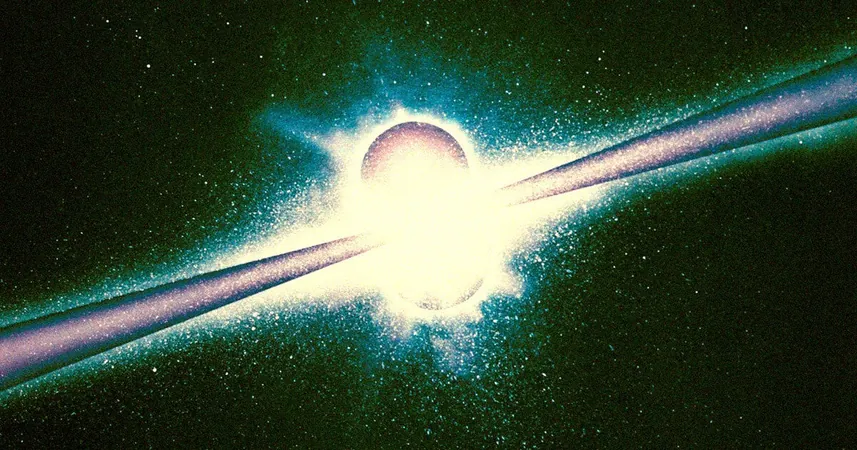
Astronomers Stunned by Mysterious Repeating Signal from Deep Space
2025-09-13
Author: Jacques
A Cosmic Mystery Unraveled
Gamma-ray bursts (GRBs) are among the most violent phenomena in the universe, releasing more energy in just seconds than our Sun will emit in its entire 10-billion-year lifetime. Traditionally, these spectacular explosions herald the death throes of massive stars, culminating in swift supernovae.
However, a recent discovery has left astronomers baffled. They have detected a GRB that seems to defy all known astronomical models by repeating multiple times within a single day, as if a star experienced consecutive catastrophic deaths.
An Unprecedented Discovery
Antonio Martin-Carrillo, an astronomer at University College Dublin and co-author of the new study in The Astrophysical Journal Letters, stated, "This event is unlike any other seen in 50 years of GRB observations." GRBs are typically single occurrences, as the cataclysmic events that create them should eliminate the star entirely.
The European Southern Observatory confirmed that the existence of this unusual signal, known as GRB 250702B, poses significant challenges for scientists. The question looms: how can a star explode multiple times?
The Basics of Star Death
To understand this anomaly, consider how stars typically meet their end. Massive stars, several times heavier than our Sun, exhaust their nuclear fuel and collapse, resulting in a supernova that scatters their remnants across space. Yet, not all stars go out in the same fiery blaze.
Some stars in binary systems may go through a unique process where one star, a white dwarf, siphons material from a companion star. This accumulation can lead to explosive thermonuclear events that destroy both stars, but even this scenario wouldn’t account for the double or triple explosions observed in GRB 250702B.
Unraveling the Mystery
The first detection of this extraordinary burst occurred on July 2, as picked up by NASA's Fermi Gamma-ray Space Telescope, which registered three unique flashes. To complicate matters, the Einstein Probe X-ray telescope had earlier noted suspicious activity almost a day before.
Co-lead author Andrew Levan from Radboud University pointed out, "This is 100 to 1000 times longer than most GRBs," but even more notably, it exhibited a periodic pattern never before seen.
Extragalactic Significance
Initially believed to originate from within the Milky Way, follow-up observations using the HAWK-I infrared camera on Chile’s Very Large Telescope revealed that the blasts were likely from billions of light years away, marking them as extraordinarily powerful events.
Martin-Carrillo commented on the excitement of this discovery: "The fact that this object is extragalactic means that it is considerably more powerful." Astronomers propose several speculative theories to explain this phenomenon.
Potential Explanations
One hypothesis suggests the star imploded under its own gravity while some material continued to fuel its core. However, this scenario typically results in GRBs lasting mere seconds.
Another possible explanation involves a tidal disruption event, which entails a star being consumed by a black hole. Yet, this theory would require the presence of an unusual star and an even stranger black hole, speculated to be an intermediate-mass black hole—a cosmic entity that has yet to be directly observed.
Steps Toward Understanding
Regardless of the ultimate cause, both potential explanations would be groundbreaking in the field of astronomy. Martin-Carrillo stated, "We are still not sure what produced this or if we can ever really find out, but this research advances our understanding of this incredibly unusual and exciting object."
As scientists continue to analyze this cosmic riddle, the discovery underscores the mysteries still lingering in our universe, leaving us eager for future revelations.









 Brasil (PT)
Brasil (PT)
 Canada (EN)
Canada (EN)
 Chile (ES)
Chile (ES)
 Česko (CS)
Česko (CS)
 대한민국 (KO)
대한민국 (KO)
 España (ES)
España (ES)
 France (FR)
France (FR)
 Hong Kong (EN)
Hong Kong (EN)
 Italia (IT)
Italia (IT)
 日本 (JA)
日本 (JA)
 Magyarország (HU)
Magyarország (HU)
 Norge (NO)
Norge (NO)
 Polska (PL)
Polska (PL)
 Schweiz (DE)
Schweiz (DE)
 Singapore (EN)
Singapore (EN)
 Sverige (SV)
Sverige (SV)
 Suomi (FI)
Suomi (FI)
 Türkiye (TR)
Türkiye (TR)
 الإمارات العربية المتحدة (AR)
الإمارات العربية المتحدة (AR)